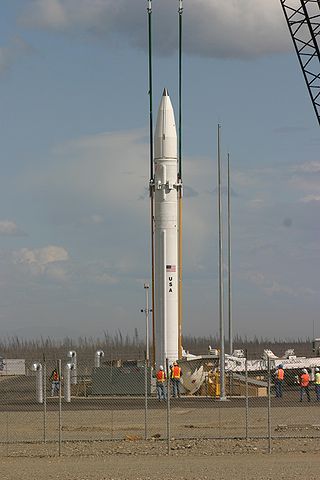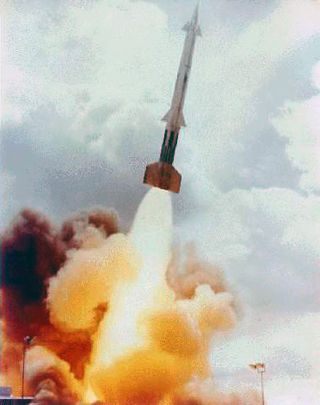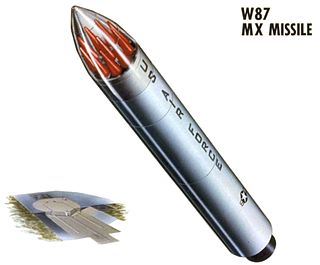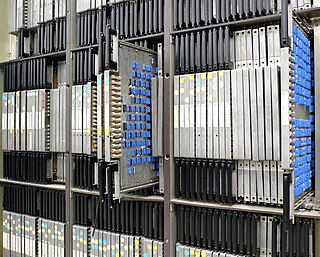Related Research Articles

An anti-ballistic missile (ABM) is a surface-to-air missile designed to counter ballistic missiles. Ballistic missiles are used to deliver nuclear, chemical, biological, or conventional warheads in a ballistic flight trajectory. The term "anti-ballistic missile" is a generic term conveying a system designed to intercept and destroy any type of ballistic threat; however, it is commonly used for systems specifically designed to counter intercontinental ballistic missiles (ICBMs).

The Anti-Ballistic Missile Treaty, also known as the ABM Treaty or ABMT, was an arms control treaty between the United States and the Soviet Union on the limitation of the anti-ballistic missile (ABM) systems used in defending areas against ballistic missile-delivered nuclear weapons. It was intended to reduce pressures to build more nuclear weapons to maintain deterrence. Under the terms of the treaty, each party was limited to two ABM complexes, each of which was to be limited to 100 anti-ballistic missiles.

The Burroughs Corporation was a major American manufacturer of business equipment. The company was founded in 1886 as the American Arithmometer Company by William Seward Burroughs. In 1986, it merged with Sperry UNIVAC to form Unisys. The company's history paralleled many of the major developments in computing. At its start, it produced mechanical adding machines, and later moved into programmable ledgers and then computers. It was one of the largest producers of mainframe computers in the world, also producing related equipment including typewriters and printers.

An intercontinental ballistic missile (ICBM) is a ballistic missile with a range greater than 5,500 kilometres (3,400 mi), primarily designed for nuclear weapons delivery. Conventional, chemical, and biological weapons can also be delivered with varying effectiveness, but have never been deployed on ICBMs. Most modern designs support multiple independently targetable reentry vehicle (MIRVs), allowing a single missile to carry several warheads, each of which can strike a different target. The United States, Russia, China, France, India, the United Kingdom, Israel, and North Korea are the only countries known to have operational ICBMs.

A multiple independently targetable reentry vehicle (MIRV) is an exoatmospheric ballistic missile payload containing several warheads, each capable of being aimed to hit a different target. The concept is almost invariably associated with intercontinental ballistic missiles carrying thermonuclear warheads, even if not strictly being limited to them. An intermediate case is the multiple reentry vehicle (MRV) missile which carries several warheads which are dispersed but not individually aimed. Only the United States, the United Kingdom, France, Russia and China are currently confirmed to have deployed MIRV missile systems. Pakistan is developing MIRV missile systems. Israel is suspected to possess or be in the process of developing MIRVs.

The Strategic Arms Limitation Talks (SALT) were two rounds of bilateral conferences and corresponding international treaties involving the United States and the Soviet Union. The Cold War superpowers dealt with arms control in two rounds of talks and agreements: SALT I and SALT II.

Chevaline was a system to improve the penetrability of the warheads used by the British Polaris nuclear weapons system. Devised as an answer to the improved Soviet anti-ballistic missile defences around Moscow, the system increased the probability that at least one warhead would penetrate Moscow's anti-ballistic missile (ABM) defences, something which the Royal Navy's earlier UGM-27 Polaris re-entry vehicles (RVs) were thought to be unlikely to do.

The ILLIAC IV was the first massively parallel computer. It is part of the ILLIAC series of computers. The system was originally designed to have 256 64-bit floating point units (FPUs) and four central processing units (CPUs) able to process 1 billion operations per second. Due to budget constraints, only a single "quadrant" with 64 FPUs and a single CPU was built. Since the FPUs all had to process the same instruction – ADD, SUB etc. – in modern terminology the design would be considered to be single instruction, multiple data, or SIMD.

START II was a bilateral treaty between the United States and Russia on the Reduction and Limitation of Strategic Offensive Arms. It was signed by US President George H. W. Bush and Russian President Boris Yeltsin on 3 January 1993, banning the use of multiple independently targetable re-entry vehicles (MIRVs) on intercontinental ballistic missiles (ICBMs). Hence, it is often cited as the De-MIRV-ing Agreement.

The CDC STAR-100 is a vector supercomputer that was designed, manufactured, and marketed by Control Data Corporation (CDC). It was one of the first machines to use a vector processor to improve performance on appropriate scientific applications. It was also the first supercomputer to use integrated circuits and the first to be equipped with one million words of computer memory.

Missile defense is a system, weapon, or technology involved in the detection, tracking, interception, and also the destruction of attacking missiles. Conceived as a defense against nuclear-armed intercontinental ballistic missiles (ICBMs), its application has broadened to include shorter-ranged non-nuclear tactical and theater missiles.

The maneuverable reentry vehicle is a type of warhead for ballistic missiles that is capable of maneuvering and changing its trajectory.
In anti-ballistic missile (ABM) defence the cost-exchange ratio is the ratio of the incremental cost to the aggressor of getting one additional warhead through the defence screen, divided by the incremental cost to the defender of offsetting the additional missile. For instance, a single new ICBM might require a single new ABM to counter it, and if they both cost the same, the cost-exchange ratio would be 1:1.
ILLIAC was a series of supercomputers built at a variety of locations, some at the University of Illinois at Urbana–Champaign. In all, five computers were built in this series between 1951 and 1974. Some more modern projects also use the name.
The Burroughs B1000 Series was a series of mainframe computers, built by the Burroughs Corporation, and originally introduced in the 1970s with continued software development until 1987. The series consisted of three major generations which were the B1700, B1800, and B1900 series machines. They were also known as the Burroughs Small Systems, by contrast with the Burroughs Large Systems and the Burroughs Medium Systems.

Nuclear weapons delivery is the technology and systems used to place a nuclear weapon at the position of detonation, on or near its target. Several methods have been developed to carry out this task.

The W71 nuclear warhead was a US thermonuclear warhead developed at Lawrence Livermore National Laboratory in California and deployed on the LIM-49A Spartan missile, a component of the Safeguard Program, an anti-ballistic missile (ABM) defense system briefly deployed by the US in the 1970s.
A penetration aid is a device or tactic used to increase an aircraft's capability of reaching its target without detection, and in particular intercontinental ballistic missile (ICBM) warhead's chances of penetrating a target's defenses.
In nuclear strategy, a counterforce target is one that has a military value, such as a launch silo for intercontinental ballistic missiles, an airbase at which nuclear-armed bombers are stationed, a homeport for ballistic missile submarines, or a command and control installation.

The AN/FPQ-16 Perimeter Acquisition Radar Attack Characterization System is a powerful United States Space Force phased-array radar system located in North Dakota. It is the second most powerful phased array radar system in the US Space Force's fleet of missile warning and space surveillance systems, behind the more modern PAVE PAWS phased array radar.
References
- 1 2 3 4 5 6 7 8 PEPE - Parallel Element Processing Ensemble Last updated on June 8, 2011.
- 1 2 R. Michael Ford (1990). Parallel supercomputing in SIMD architecture (1st ed.). CRC Press. p. 7. ISBN 0-8493-4271-6.
- ↑ Real-Time Advanced Data Processing Parallel Element Processing Ensemble (PEPE), June 30, 1973, Final Report for Contract DAHC60-72-C-0031, prepared by the System Development Corporation of Huntsville, Alabama for the U.S. Army Advanced Ballistic Missile Defense Agency.
- ↑ Donnelly, Deirdre (24 September 1976). "New computer generation to work much faster". Tucson Citizen.
- ↑ "PEPE". Burroughs B-Line. July 1977.
- 1 2 3 4 Sidnam, Robert (1976). PEPE, The Supercomputer. System Development Corporation.